Magic has been a meaningful part of my life for almost 20 years, and Commander for more than half of that time. While I don’t always consider myself to be the foremost authority on the goings on of the format throughout its entire history, I get joy from actively cataloging topical parts of the format when inspiration strikes. This week, I turn my attention to the topic of Voltron decks, a vital part of Commander that have begun to feel misunderstood.
Voltron is a strategy unique to Commander, because of the existence of commander damage—when a commander deals 21 combat damage to a single player, that player is removed from the game. As such, the viability of Voltron within the format has waxed and waned with the power level and relevancy of the generals that are en vogue. What I would like to investigate today is the high points of the strategy, what drove the archetype during different points in Commander’s history, and how each development expanded the archetype.
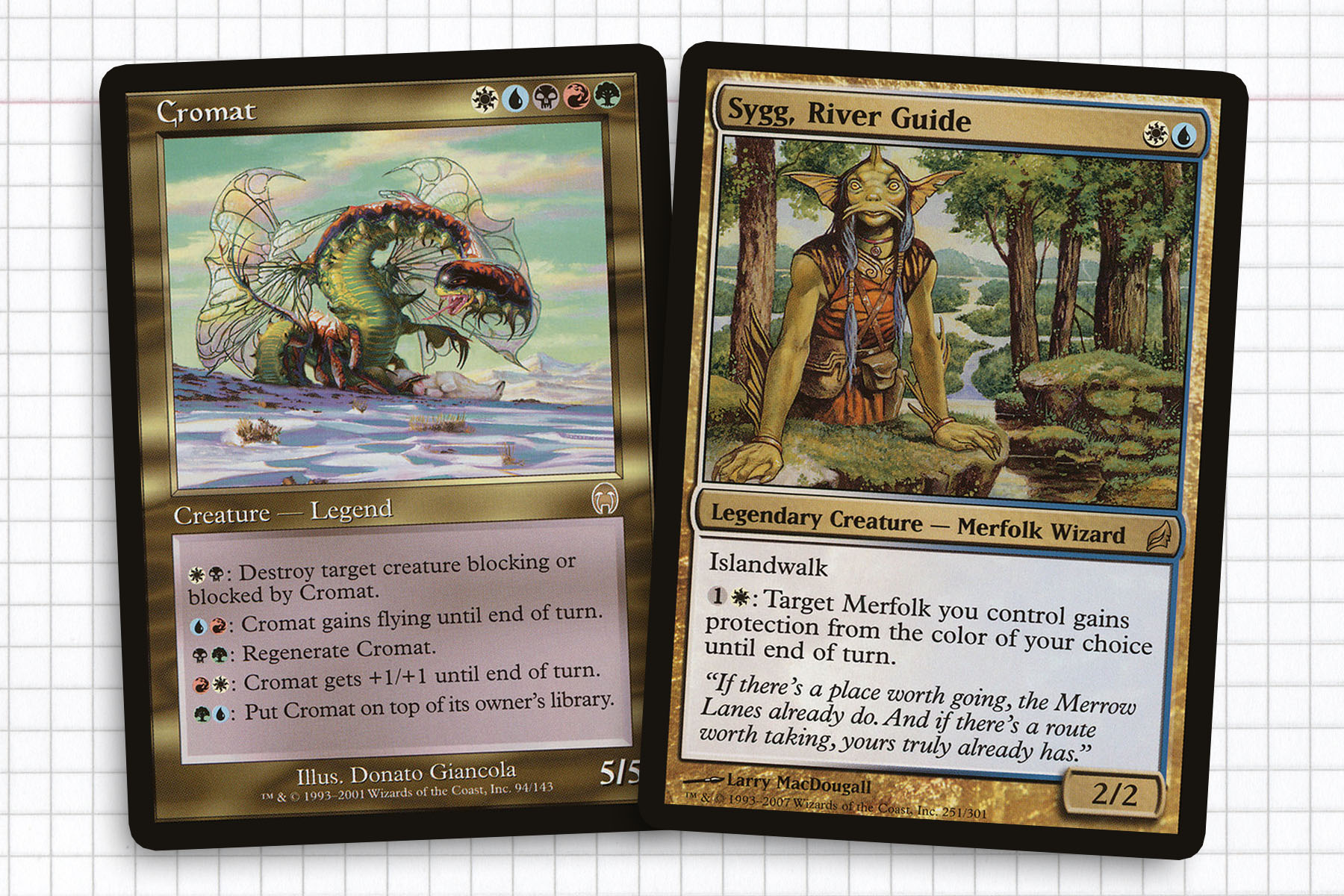
The Dawn of EDH
The dawn of the format pretty well exemplified the general sentiment that with enough energy, any legendary creature can function as a Voltron general. This makes pinning down exact creatures that would have been the go-to Voltron generals rather nebulous. Beyond the original five elder dragons, all of whom needed three uninterrupted attacks to provide lethal commander damage, I wanted to try to give an outline of what the archetype looked like over the first years of the format.
Asking around and doing research, like listening to the early episodes of Commander Cast and reading early Bennie Smith articles, helped illuminate the philosophies of the time, the shape of Commander, and how the strategy of winning through commander damage was perceived. What I found was that due to the speed of the format, any deck could include Empyrial Plate or Loxodon Warhammer to allow their general to plan for commander damage in the long run. Games were expected to run for over 90-minutes each, and players could expect to take turns into the double digits. In this environment, Voltron seems to have been an ideal safety valve ensuring that games did in fact end.
But in the end, generals seemed to fall into one of three camps: cheap generals such as Isamaru, Hound of Konda would be suited up with equipment; slower prison decks like Zur, the Enchanter would control the game and use their later turns to fetch out auras like Battle Mastery, Daybreak Coronet, and Shade’s Form; or generals like Sygg, River Guide and Cromat had ways to protect themselves baked into their design. With this in mind, we can work to identify the Voltron generals of future sets.
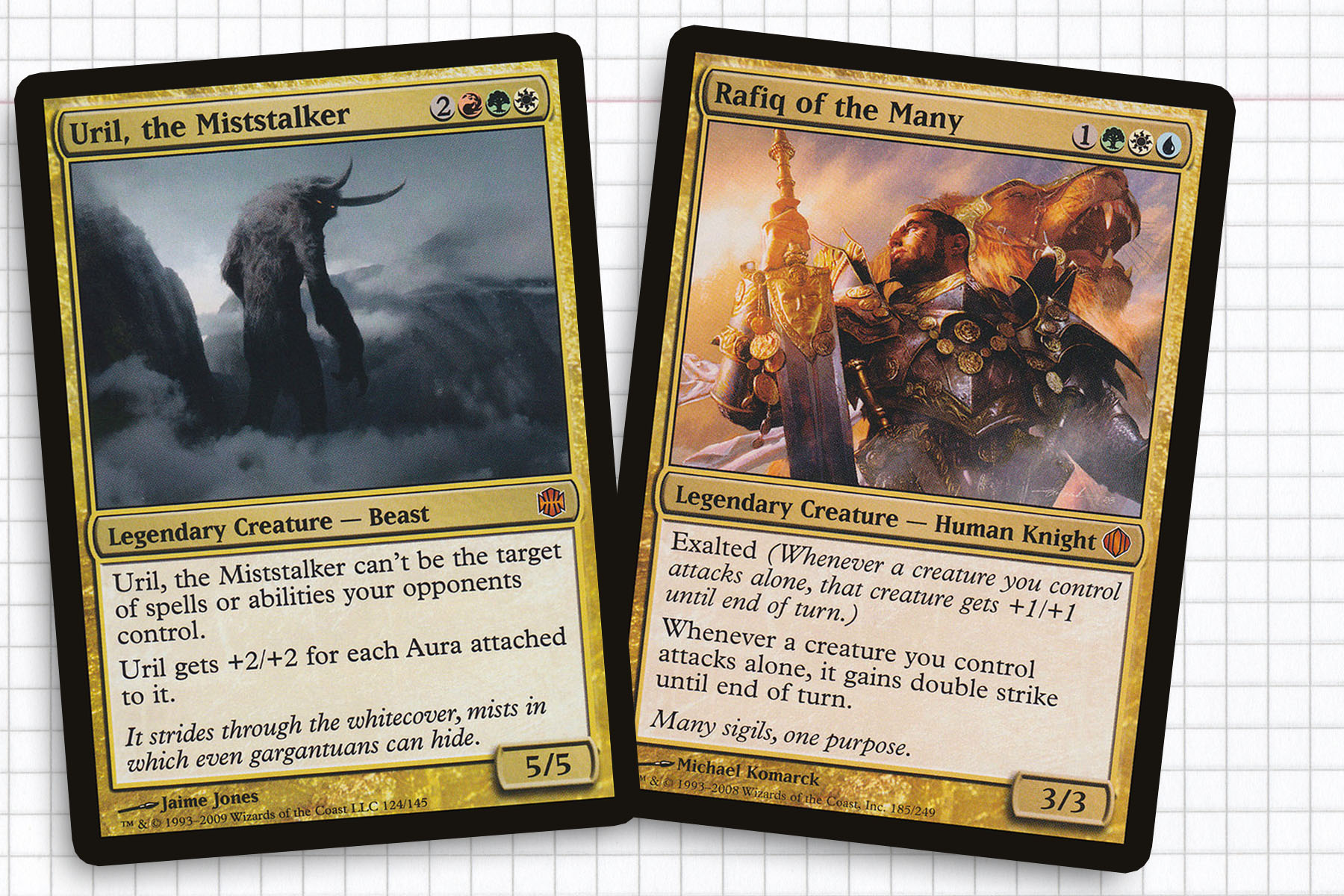
Shards of Alara
Looking at the history of the Voltron, it is unquestionably Shards of Alara that forever changed the archetype. Within one set we were given Rafiq of the Many and Uril, the Miststalker, two impactful legendary creatures that epitomize what a Voltron deck could look like in completely different ways. They were likely juiced by the fact that as three-color generals, they delivered on en vogue trends during this time. They were the right legendary creatures at the right time.
Rafiq of the Many worked in contrast to how a lot of Voltron decks might be perceived today. Whereas a typical deck list will prioritize protecting and enhancing one creature, Rafiq wanted to swarm the board, while ironically only attacking with one creature. The typical creature suite included exalted premanants like Battlegrace Angel, Finest Hour, and Qasali Pridemage to provide massive bonuses to a single attacker, while staying back as blockers. Additionally, Rafiq would use Stoic Angel, a current hidden gem that would disproportionately benefit this strategy and disincentive massive alpha strikes.
Uril, the Miststalker is the most significant Voltron general in the history of the format. While the card may not have been explicitly built for Commander, it was built in a world where Wizards R&D knew that the format existed. By having what would become hexproof and an ability that rewards the use of auras, Uril had all of the makings to win through commander damage. Early builds would use auras like Armadillo Cloak, Rancor, and Runes of the Deus to not only attack for player removal, but inflate their own life totals to protect against decks that were going to win through conventional damage.
Not too long after, Eldrazi Conscription would be printed and both Rafiq and Uril players would find ways to make it fit into their decks. Rafiq also took a nod from then-current Standard and used Sovereigns of Lost Alara to attach it to him from the library. As much as there would still be notable Voltron options in the future, these two had the most gravity in the format for quite some time. Even now, I would contend that Uril is the face of the Voltron archetype.
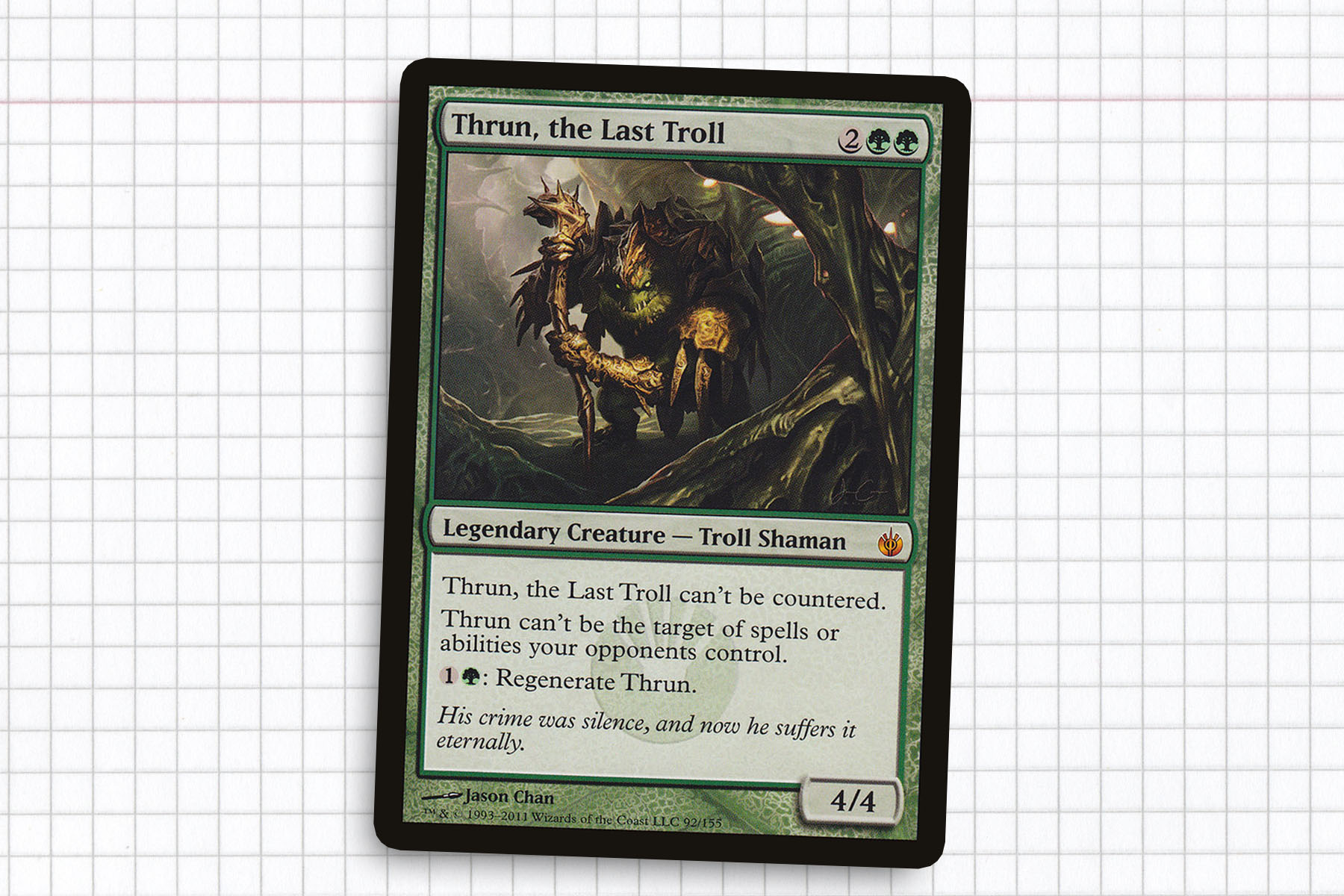
Traversing the Planes
In the years following Alara, we had two notable and different breeds of Voltron deck. First we had Thrun, the Last Troll, who like Sygg, River Guide and Uril, proved easy to protect on his own merits. The deck moved very quickly, using the strength of mono green spells like Arbor Elf, Birds of Paradise, Nature’s Lore, and Rampant Growth to ensure a turn three Thrun. From there the ramp went towards big mana spells like Increasing Savagery and Eldrazi Conscription to make the general terrifying. The mana could also go towards land destruction spells such as Acidic Slime, Reap and Sow, and Woodfall Primus, to prevent control decks from stopping Thrun with Iona, Shield of Emeria. For a time, this deck was a prime target for the table.
The other, more contentious general to receive the moniker of Voltron general was Geist of Saint Traft. Having hexproof and the ability to generate another attacker for a low mana value meant that the higher parts of the mana curve could be dedicated to midrange and control effects. Batterskull and Sword of Feast and Famine were particularly useful, as they were actively gaining life and resetting lands, respectively. The deck easily brushed aside Wrath-effects from any player with Karmic Guide, Sun Titan, and Marshal’s Anthem. While not as in-your-face aggressive as most of the generals that came before, the deck would play towards the long game and find game-ending spells at its own pace.
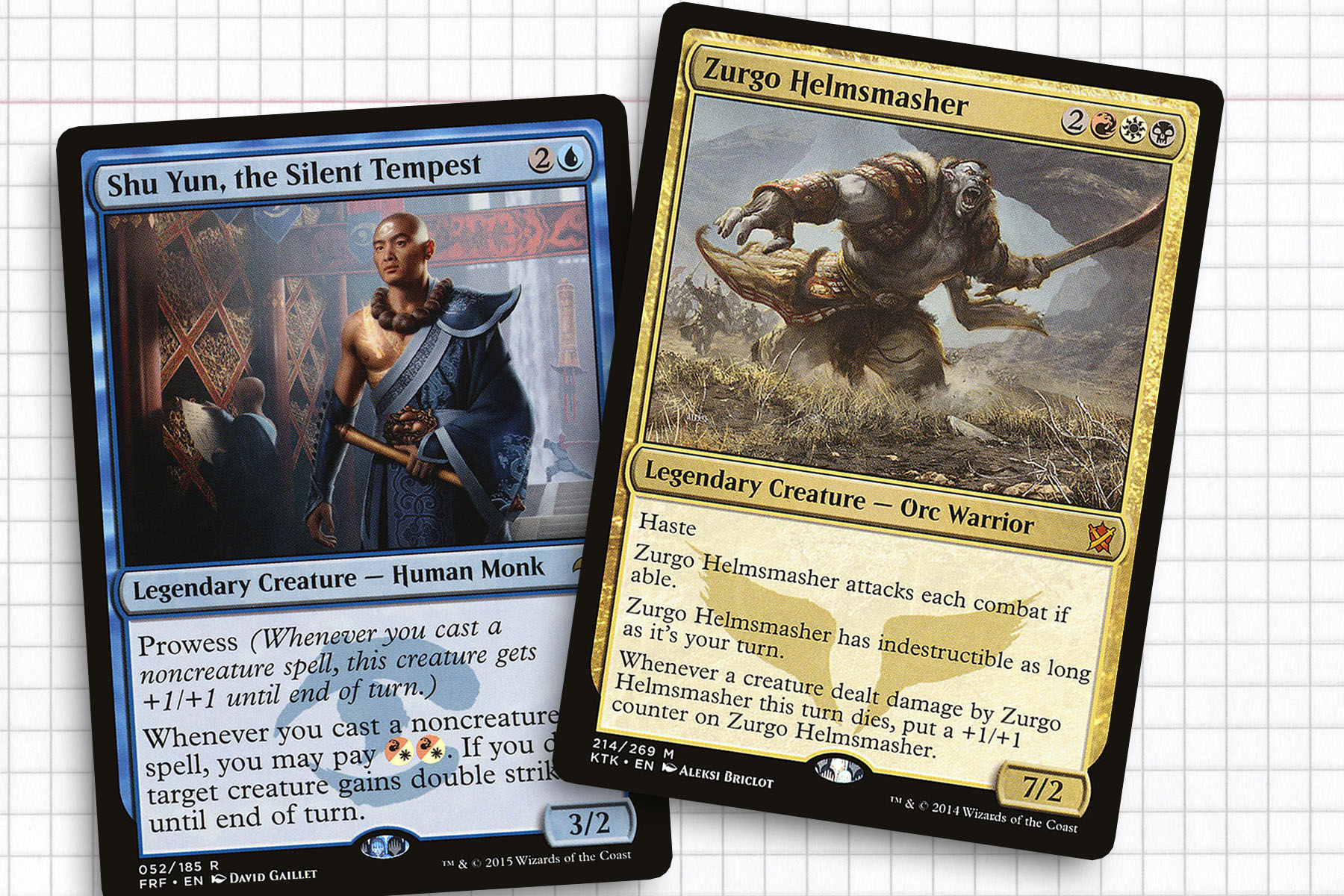
Respect the Khans
Khans of Tarkir block was incredibly influential to Commander, by many accounts, falling just short of the influence of the Alara block. Tarkir’s three-color faction world meant that for many people discovering the format too late to find Commander 2011 at their local gaming store, they would finally have access to wedge generals. It’s no wonder that just like Alara block, at least one iconic Voltron general would rise above the rest.
Zurgo Helmsmasher was the first general that I witnessed come into their own in real time. Zurgo was a fairly popular general on release, doing novel things with equipment like Tenza, Godo’s Maul and Hot Soup. Assault Suit came out in Commander 2014 only six weeks after Zurgo’s release, after which the two became inextricably entwined into a marquee combo. The deck was fun, because it put everyone in the driver’s seat when it came to dowling out commander damage for the same player, but terrifying because an underprepared table could lose in a few turns.
The design of Zurgo is blatant aboiut what to do with him: haste, attack every turn, conditional indestructibility, and the death trigger made popular by Sengir Vampire. All of these build towards a very aggressive creature. And to me, Zurgo is one of the generals I would put on the Commander Mount Rushmore, because it defined so much of that era without being demoralizing. It is a little disheartening to see how far Zurgo has fallen within the Mardu color identity, currently as the tenth most popular general with less than 1,000 decks. Overshadowed by creatures with more linear purpose and nuances, but hopefully not forgotten.
Coming out of the same block, Shu Yun, the Silent Tempest was a new twist that I don’t know had been embraced previously: a spells-matter Voltron general. Instead of specifically suiting a general up with a load of auras and/or equipment, Shu Yun utilized prowess to grow considerably big off of noncreature spells, and targeting itself with their triggered ability to wipe an opponent out in a single strike.
The deck itself used tools like Artful Dodge, Distortion Strike, Shadow Rift, and Slip Through Space to ensure that their game ending blow would land without interference and in one attack. As a result, the sentiment at the time was that you could never let your shields down, because the Shu Yun player was simply looking for one opening to remove someone from the game. Unlike Zurgo Helmsmasher, I don’t know that Shun Yun inspires the same level of praise. He is not nearly as iconic to the time and I don’t know that he comes to mind when many people try to make a list of Voltron generals, though I would contend that the two are nearly equal in potency.
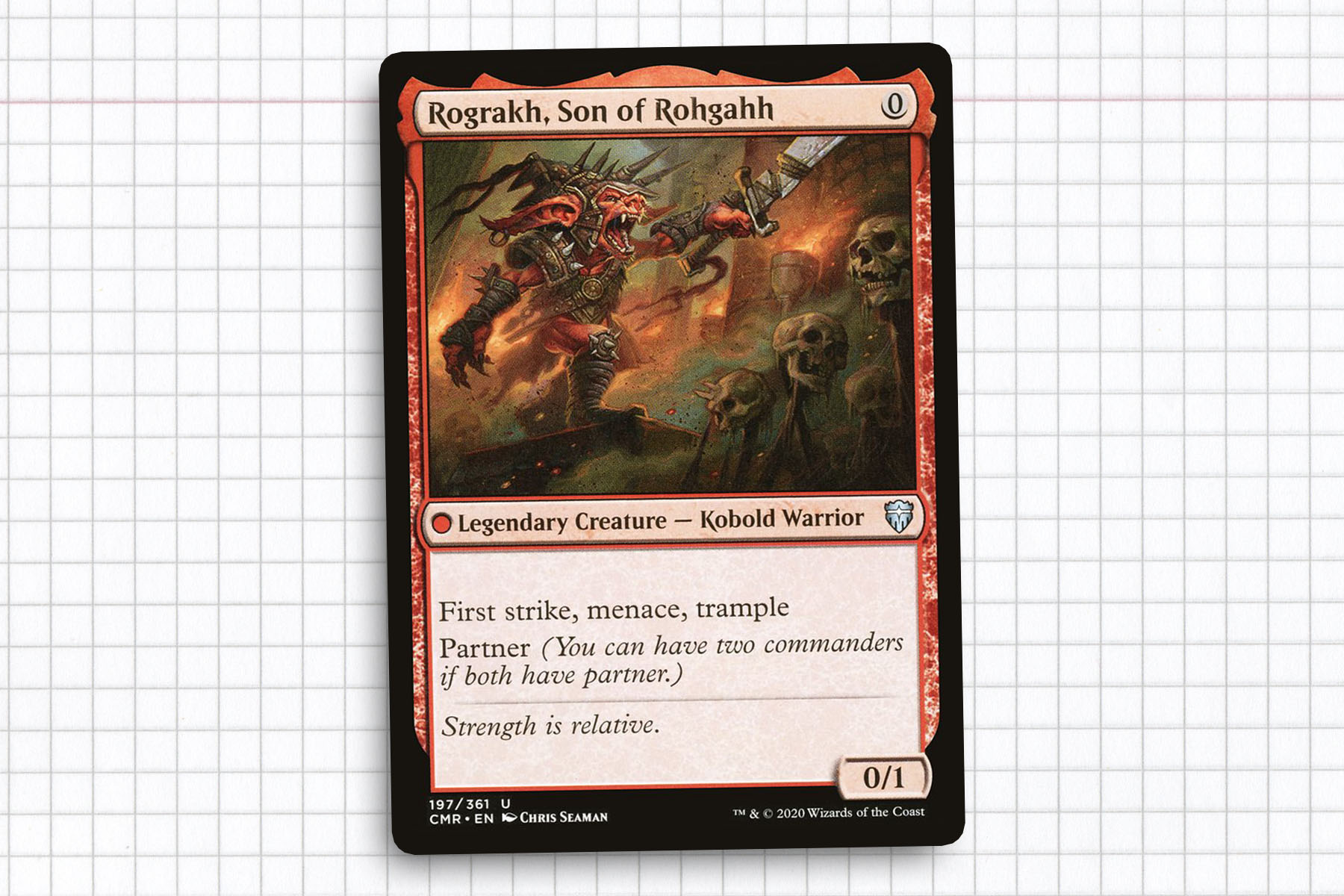
Contemporary Context
It would be foolish to say that the Voltron strategy all but disappeared in the last six years. But the popularity and growth of the format, along a design principle that has led to legendary creatures being value engines instead of bodies that attack, has led to a lowering of Voltron’s profile. We still get legendary creatures like Mirri, Weatherlight Duelist, but their impact has been lessened.
Relatively recently, we had the chance to take the archetype exemplified by Isamaru, Hound of Konda in early Commander and bring it to its most extreme. Rograkh, Son of Rohgahh, hilarious as it might seem on the surface, has all the right abilities to make an impression—he just needs the right elegant weapons to put those skills to use. The general consensus at the time of writing seems to be partnering Rograkh with Ardenn, Intrepid Archaeologist as a strong starting point for a Voltron deck. This pairing allows the immediate attaching of Colossus Hammer either with Ardenn’s combat trigger or the trusty Puresteel Paladin, making the Kobold into something terrifying. The lesson here is that no stone should be left unturned in the search for the next great general.
As a strategy unique to Commander, Voltron decks will always be a consideration as their viability fluctuates within the metagame. Hopefully, this look into the archetype over the course of most of Commander’s history has been enlightening. You should also check out Kristen Gregory’s article from earlier this year, Why Voltron Isn’t Viable in Casual Commander, which I would recommend for an insightful, additional perspective on the subject matter. Until next time, thanks for reading.
Ryan Sainio is a Graphic Designer who writes about EDH and the EDH community. He has been playing Magic: the Gathering since 7th Edition in 2002 and values flavorful and fun gameplay over competitively optimized decks.

